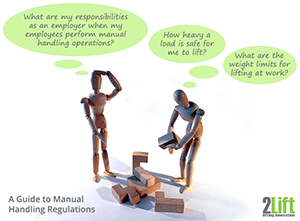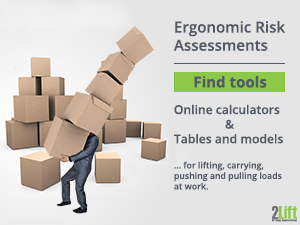Australia
Ergonomic Risk Assessment Tools and Manual Handling Regulations in Australia
If your workers are carrying out any form of manual handling operation at work, there are a number of important things you need to know as an employer in order to comply with the law and to protect your workers from accidents and injuries.
This page on ergonomic risk assessment tools and manual handling regulations in Australia has been created with the aim of giving you an overview of what you need to know about the topic of manual handling and to help you find the specific material that you need.
On this page you’ll get:
- A quick introduction to the main authority dealing with and the laws (acts, regulations and code of practices) regarding manual handling in Australia
- A brief walkthrough the typical risk factors in manual handling in order to be able to identify a hazardous manual handling task
- Links to ergonomic risk assessment tools so you can carry out your own ergonomic risk evaluation
- Old weight limits for lifting (apparently there are no maximum weight limits any more for how much you may lift at work)
Authorities and Laws Dealing with Manual Handling and Risk Assessment Tools in Australia
In some ways (but by no means all) the workings of the safety and health laws in Australia and its states and territories can be compared to that of the EU and its member states.
In Europe, the EU sets the overall legislation and minimum safety requirements for manual handling, which the EU member states have to follow and find ways implement in their own country (e.g. by creating their own ergonomic risk assessment tools).
However, to a fairly large degree, the member states are free to choose how they will comply with EU directives as as long as they abide to the overall framework. Each EU member state is responsible for enforcing the laws in their own country. (Read more about manual handling in the EU here)
In Australia there is a similar pattern as we have the overall Commonwealth of Australia along with its different states and territories. However, these states and territories have different governing status (some are self-governing, some are not), which means that that the system in Australia works in a somewhat different way than that of the EU.
Let’s take a closer look at what that means.
The Policy Developer: SWA (Safe Work Australia)
When it comes to safety and health politics, one of the most important players in Australia is the SWA (Safe Work Australia),which is a government statutory body endowed with the responsibility of, among other things, developing national policies and strategies.
However, even though SWA is responsible for drawing up policies and laws, it is not responsible for enforcing them or to advise people on how to live up to them. That responsibility belongs to the individual states and territories. (reference)
Health and Safety Laws in Australia
SWA have developed what is called model WHS laws back in 2011. In order for the model WHS laws to be “legally binding, the Commonwealth, states and territories must separately implement them as their own laws.”
The model WHS laws include several different elements (act, regulations, codes of practices). And as already touched upon, these elements do not automatically apply in a jurisdiction – they have to be passed (Act), made (regulations) or approved (codes of practices) in the particular jurisdiction in question.
Thus to see whether or not any of these elements apply to your business, you need to address your own state or territory to see what has been accepted / passed there.
The Model WHS Laws and Manual Handling
As mentioned, the model WHS laws include several elements.
The elements include:
The model WHS Act
The model WHS Act’s purpose is to provide an overall framework to ensure the safety and health of workers, including that of requiring employers to eliminate or reduce risks. This Act is implemented in most jurisdictions, but it is not all that relevant for the specific subject of manual handling
The model WHS Regulations
The model WHS Regulations’s purpose is to describe which requirements are needed to live up to the responsibilities laid out in the model WHS Act. What is of interest here is the employers’ responsibilities when workers are carrying out manual handling tasks. We’ll look into those responsibilities in a bit.
The model Codes of Practice
The model Codes of Practice’s purpose is to provide practical guidelines on how to comply with the Act and Regulations. In a bit we’ll take a closer look at the Hazardous Manual Tasks. Code of Practice which describes in detail what you need to do as an employer if manual handling occurs at your workplace.
Thus when it comes to the subject of manual handling in terms of employer responsibilities and how-tos, we need to look into:
- The model WHS Regulations and
- The model Codes of Practice
The Responsibilities of the Employer in the Model WHS Regulations
In the model WHS Regulations it says that it is the responsibility of an employer to manage all the risks to safety and health associated with a manual handling task. The risk that is given particular attention is that of MSD (Musculoskeletal disorders).
Very briefly put the model WHS Regulations says that it is the employer’s responsibility to:
- Identify potential hazards (which includes ergonomic ones)
- Manage the risks in terms of either eliminating them or minimizing them.
If the employer can’t eliminate the risk (if it’s not “reasonably practicable”), then the employer must implement control measures and minimise the risks.
The employer must also be aware of and pay attention to all factors that may contribute to MSD such as e.g.:
- “postures, movements, forces and vibration”
- “the duration and frequency of the hazardous manual task”
- “workplace environmental conditions that may affect the hazardous manual task or the worker performing it”
Manual Handling and Ergonomic Risk Assessment Tools
 Thus it is the employer’s responsibility to use ergonomic risk assessment tools (or other evaluation tools) to make sure that the manual handling tasks do not constitute a risk of MSD for the workers.
Thus it is the employer’s responsibility to use ergonomic risk assessment tools (or other evaluation tools) to make sure that the manual handling tasks do not constitute a risk of MSD for the workers.
In the afore mentioned Hazardous Manual Tasks. Code of Practice you’ll get a thorough step-by-step guide as to how to approach manual handling tasks at work.
You’ll get to learn how to:
- Identify risky manual handling operations (what are the risk factors and warning signs?)
- Assess the risk of MSD (how to evaluate whether or not a manual handling task pose a risk)
- Eliminate and reduce risks (what are possible control measures to take?)
- Review the control measures (do they work as planned and protect the workers?)
Identifying a Risky Manual Handling Operation
In the Hazardous Manual Tasks. Code of Practice 5 factors are mentioned as characteristics of a “hazardous manual task” (a task with the potential of creating MSDs):
- The use of force that is sustained and repetitive. (If the force that is sustained is held for more than 30 seconds at a time and if the force is repetitive (performed more than twice a minute), then the concept of “duration” must be considered. If the threshold for sustained and repetitive force is passed, then the task may not last more than a maximum of two hours per work day shift or continuously for more than 30 minutes at a time).
- The use of sudden or high force
- Repetitive movements.
- Postures that are awkward and sustained (e.g. bending the head forwards or sideways more than 20 degrees, bending the back forwards or sideways more than 20 degrees, twisting the back more than 20 degrees etc.)
- Exposure to vibration
Other risk factors are:
- Work area layout and environment (temperature, not too cold or warm, flooring – level, not slippery, adequate lighting etc.)
- Load characteristics: weight (not too heavy), shape (not too awkward), gripping ability (good grip on the load) etc.
- The system of work: enough pauses, working pace set by the worker, skills to carry out the task without risk, guidance to lift and carry the load in a correct ergonomic manner
– other than that, one must simply pay attention to whether the task is difficult and tiring or cause discomfort.
You can carry out your own manual handling evaluation with this example of ergonomic risk assessment tools:
– Check out appendix D: Risk assessment worksheet
Weight Limits for Lifting at Work in Australia
Sorry, apparently there aren’t any limits as to how much a person may lift at work in Australia (and no force limits for pushing and pulling either).
Apparently there used to be some guidelines for the maximum weight of a load to be lifted at work, but it has now been recognized that such weight limits can be misleading as people have very different physical capabilities.
Instead the focus has now shifted to using ergonomic risk assessment tools as a more precise method. Thus in the Hazardous Manual Tasks. Code of Practice there are (as far as we can see) no weight limits for lifting.
However, in the old National Code of Practice for Manual Handling [NOHSC:2005(1990)], the guidelines for maximum weight to lift were:
- Lift no more than 4.5 kg from a seated position
- When lifting more than 16 kg, be aware that the risk of injury (MSD) increases
- No one should manually lift more than 55 kg
Other Online Resources Related to Manual Handling and Risk Assessment Tools in Australia

- Lifting, pushing and pulling (manual handling)
- Hazardous Manual Tasks. Code of Practice
- Model Code of Practice: How to manage work health and safety risks
- Identify, assess and control hazards
- National Code of Practice for Manual Handling [NOHSC:2005(1990)]
- The model WHS Act
- The model WHS Regulations
- The model Codes of Practice
Special Copyright Notice
This page contains reproduced information created by Safe Work Australia which is licensed under the Creative Commons Attribution-Noncommercial 3.0 Australia licence. This notice applies to the illustration Appendix A – The Risk Management Process for Manual Tasks from the publication Hazardous Manual Tasks. Code of Practice.
Information Disclaimer
We have done our very best to ensure the accuracy and reliability of the information presented on this page. However, we cannot guarantee the correctness of any information (regulations change from time to time, responsibilities change hands, etc.). Thus we cannot accept any responsibility or liability for the accuracy, content, completeness, legality, or reliability of the information provided here.
If, however, you are aware of any outdated or incorrect information on this page, you are very welcome to contact us, so we can bring our page up to date.
Other Pages on Manual Handling Regulations
Country Specific Pages with Ergonomic Guidelines and Risk Assessment Tools
Go to Ergonomics for an overview of rules and regulations worldwide.
Go to our Homepage.


















